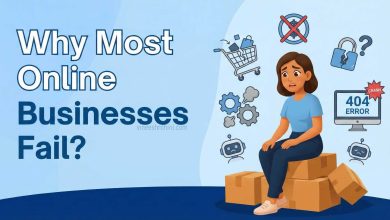Ecommerce – Hand Guide – Start Your Own Ecommerce – Free Ebooks
What is Ecommerce
Ecommerce, also known as electronic commerce, refers to the buying and selling of goods and services over the internet. Ecommerce has become increasingly popular in recent years due to the growing number of internet users, advancements in technology, and the convenience it offers to customers. Ecommerce offers several advantages to both businesses and customers. For businesses, ecommerce can provide a cost-effective way to reach a global audience, reduce operational costs, and increase revenue. For customers, ecommerce provides the convenience of shopping from anywhere, at any time, and access to a wide range of products and services.
Ecommerce, or electronic commerce, is a rapidly growing industry that has revolutionized the way that people buy and sell goods and services. The rise of ecommerce has been driven by the increasing popularity of online shopping and the convenience that it provides to customers. In this essay, we will explore the benefits and challenges of ecommerce, as well as its impact on society.
One of the biggest benefits of ecommerce is that it allows businesses to reach a global audience. With the internet, businesses can sell their products and services to customers in any part of the world, without the need for a physical store. This can significantly increase revenue for businesses and also offer consumers a wider selection of products to choose from.
Ecommerce also offers the convenience of shopping from anywhere, at any time. Customers can browse products, make purchases, and receive deliveries without ever leaving their homes. This can save time and provide a more comfortable shopping experience for many people.
In addition, ecommerce has helped to reduce the operational costs of businesses. By eliminating the need for physical stores and sales staff, businesses can save money on rent, utilities, and employee salaries. This can allow businesses to offer products and services at a lower price point, which can be beneficial for both businesses and consumers.
Despite the many benefits of ecommerce, there are also several challenges that businesses must overcome. One of the main challenges is cybersecurity. With the increasing volume of online transactions, cybercriminals are becoming more sophisticated in their attempts to steal sensitive information from businesses and customers. To protect themselves from cyberattacks, businesses need to invest in secure payment gateways, firewalls, and other security measures.
Another challenge of ecommerce is supply chain management. In order to provide customers with fast and efficient delivery, businesses need to have a reliable supply chain in place. This includes partnerships with suppliers, transportation providers, and warehousing companies. Any disruption in the supply chain can lead to delays and lost revenue.
Ecommerce also presents a challenge for businesses in terms of logistics. With the increase in online orders, businesses need to have an efficient and cost-effective system in place to fulfill orders and manage inventory. This can be particularly challenging for businesses that offer a wide range of products or have complex logistics needs.
Despite these challenges, ecommerce has had a profound impact on society. It has made it easier for people to shop and access products and services, particularly in rural areas where traditional brick-and-mortar stores may not be available. Ecommerce has also created new job opportunities, particularly in areas such as digital marketing, web development, and logistics.
features of ecommerce
Ecommerce, or electronic commerce, is the buying and selling of goods and services online. Ecommerce has become a vital component of the modern business landscape, and it offers many features that make it an attractive option for businesses and consumers alike. Here are some of the key features of ecommerce:
- Online shopping: Ecommerce allows customers to browse and purchase products or services online, without the need for a physical store. This is a convenient option for customers who can shop from anywhere, at any time.
- Payment gateways: Ecommerce platforms offer secure payment gateways that allow customers to make payments online. These gateways are designed to keep customer information safe and secure.
- Mobile optimization: With the increase in mobile usage, ecommerce platforms are designed to be mobile-friendly, with responsive web designs and dedicated mobile apps. This allows customers to shop and make purchases on their mobile devices.
- Personalization: Ecommerce platforms can offer personalized shopping experiences for customers. This includes personalized product recommendations, targeted promotions, and customized shopping carts.
- Customer reviews: Ecommerce platforms allow customers to leave reviews of products or services, which can help other customers make informed purchasing decisions. This also provides valuable feedback for businesses to improve their products and services.
- Analytics: Ecommerce platforms offer analytics tools that allow businesses to track sales, customer behavior, and other key metrics. This information can be used to improve marketing strategies, optimize inventory management, and enhance the customer experience.
- Shipping and delivery: Ecommerce platforms offer various shipping and delivery options, including next-day delivery, standard shipping, and free shipping. This allows businesses to provide flexible and convenient options for customers.
- Inventory management: Ecommerce platforms offer inventory management tools that allow businesses to keep track of stock levels, manage product listings, and update product information in real-time.
- Multi-channel selling: Ecommerce platforms allow businesses to sell their products and services through multiple channels, including their website, social media, and online marketplaces. This provides businesses with a wider reach and more opportunities to sell their products.
- Customer service: Ecommerce platforms offer customer service tools, such as live chat, email support, and phone support. This allows businesses to provide prompt and efficient customer service to customers.
Advantages of Ecommerce
Ecommerce, or electronic commerce, has revolutionized the way businesses operate and the way consumers shop. Here are some of the key advantages of ecommerce:
- Increased reach: Ecommerce allows businesses to reach a wider audience, including customers in different geographic locations. This can result in increased sales and revenue.
- Convenience: Ecommerce allows customers to shop from the comfort of their own homes or on-the-go, at any time of the day or night. This eliminates the need to visit physical stores, saving time and effort.
- Cost-effective: Ecommerce eliminates the need for physical stores, reducing overhead costs such as rent, utilities, and staff. This can result in cost savings for businesses, which can be passed on to customers through lower prices.
- Increased sales opportunities: Ecommerce provides businesses with the opportunity to sell their products and services through multiple channels, such as their own website, social media, and online marketplaces. This can result in increased sales and revenue.
- Personalization: Ecommerce platforms can offer personalized shopping experiences for customers, such as product recommendations based on their previous purchases or browsing history. This can enhance the customer experience and increase customer loyalty.
- Analytics: Ecommerce platforms offer analytics tools that allow businesses to track sales, customer behavior, and other key metrics. This information can be used to improve marketing strategies, optimize inventory management, and enhance the customer experience.
- Better inventory management: Ecommerce platforms offer inventory management tools that allow businesses to keep track of stock levels, manage product listings, and update product information in real-time. This can result in more efficient and effective inventory management, reducing the risk of stockouts or overstocking.
- Improved customer service: Ecommerce platforms offer customer service tools, such as live chat, email support, and phone support. This allows businesses to provide prompt and efficient customer service to customers, resulting in increased customer satisfaction and loyalty.
- Global opportunities: Ecommerce allows businesses to sell their products and services to customers in different countries, opening up new markets and revenue streams. This can result in increased sales and revenue.
- Scalability: Ecommerce platforms are designed to be scalable, meaning that businesses can easily increase or decrease their capacity to handle sales as demand fluctuates. This provides businesses with greater flexibility and agility to respond to changing market conditions.
Build your Own online store
Building an online store with WordPress and WooCommerce is a relatively straightforward process. Here are the basic steps:
- Install WordPress: To get started, you will need to install WordPress on your website. Many web hosts offer one-click installs of WordPress, making it easy to get started.
- Install WooCommerce: Once you have WordPress installed, you can add the WooCommerce plugin. You can do this by navigating to the “Plugins” section of your WordPress dashboard and searching for “WooCommerce.” Click “Install Now” and then “Activate.”
- Configure WooCommerce settings: Once you have installed WooCommerce, you will need to configure some basic settings, such as your store’s location, currency, and payment options. Navigate to the “WooCommerce” section of your WordPress dashboard and follow the prompts to set up your store.
- Choose a theme: The appearance of your store is important, so you will need to choose a theme that suits your brand and products. You can choose from a wide range of free and paid themes, and customize the design to your liking.
- Add products: With your store set up, you can now add products to your inventory. Navigate to the “Products” section of your WordPress dashboard and click “Add New” to create a product listing. You can add product descriptions, images, prices, and other details.
- Configure shipping and tax settings: You will need to configure your store’s shipping and tax settings to ensure that your customers are charged the correct amounts. Navigate to the “WooCommerce” section of your WordPress dashboard and click on “Shipping” and “Tax” to configure these settings.
- Test your store: Before launching your store, it’s important to test it thoroughly to ensure that everything is working correctly. Try placing orders, making payments, and navigating the site to ensure that everything is functioning as it should.
- Launch your store: Once you are satisfied that everything is working correctly, you can launch your store and start promoting it to potential customers.
By following these steps, you can build an online store with WordPress and WooCommerce. Of course, there are many additional features and settings that you can customize to suit your needs, but these basic steps will get you started.
Scope of Ecommerce
The scope of ecommerce is vast and rapidly growing, with more and more consumers turning to online shopping for their needs. Here are some of the key areas where ecommerce is having a significant impact:
- Retail: Ecommerce has transformed the retail industry, with more and more consumers choosing to shop online rather than in physical stores. Online marketplaces such as Amazon and eBay have made it easier than ever for consumers to browse and purchase products from a wide range of retailers.
- Services: Ecommerce is not just limited to the sale of physical products. Many service-based businesses, such as travel agencies, event planners, and professional services firms, now offer their services online through ecommerce platforms.
- Mobile commerce: The rise of smartphones and other mobile devices has led to an explosion in mobile commerce, or “m-commerce.” Consumers can now shop and make purchases from their mobile devices, which has opened up new opportunities for businesses to reach customers on the go.
- B2B ecommerce: Ecommerce is not just for consumer-facing businesses. Many B2B businesses are now using ecommerce platforms to sell their products and services to other businesses, streamlining the purchasing process and increasing efficiency.
- International trade: Ecommerce has made it easier for businesses to reach customers in other countries, opening up new markets and opportunities for growth. Cross-border ecommerce is expected to continue to grow in the coming years.
- Social commerce: Social media platforms are increasingly becoming a key channel for ecommerce, with many businesses using social media to promote their products and drive sales. Social commerce is expected to become even more important in the future.
- Subscription services: Many businesses now offer subscription-based services, such as meal delivery, beauty products, or software, through ecommerce platforms. This model allows businesses to build recurring revenue streams and increase customer loyalty.
The scope of ecommerce is vast and encompasses a wide range of industries and business models. As technology continues to evolve and consumers become more comfortable with online shopping, the opportunities for ecommerce are only expected to grow. Businesses that embrace ecommerce and adapt to the changing landscape are likely to be the most successful in the years to come.
In conclusion, ecommerce is a rapidly growing industry that has changed the way that people buy and sell goods and services. It offers numerous benefits, including global reach, convenience, and cost savings, but also presents challenges such as cybersecurity risks, supply chain management, and logistics. With the right strategies and investments, businesses can overcome these challenges and continue to thrive in the ecommerce landscape.





